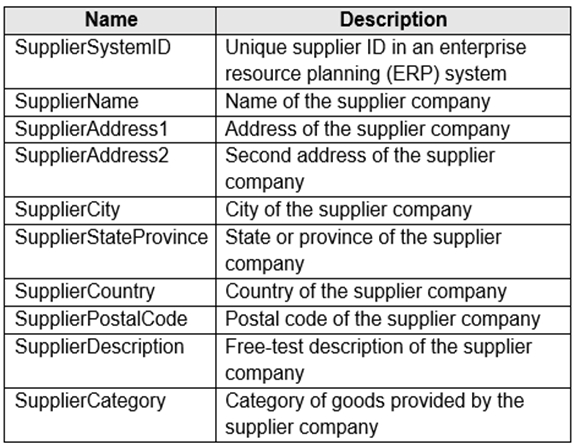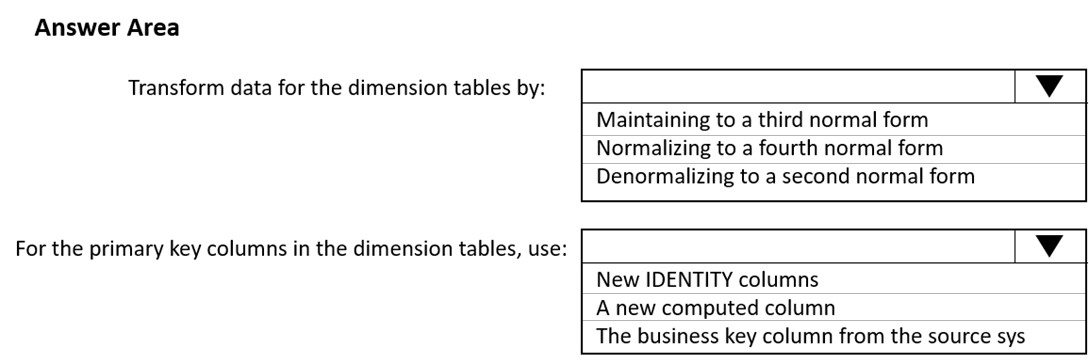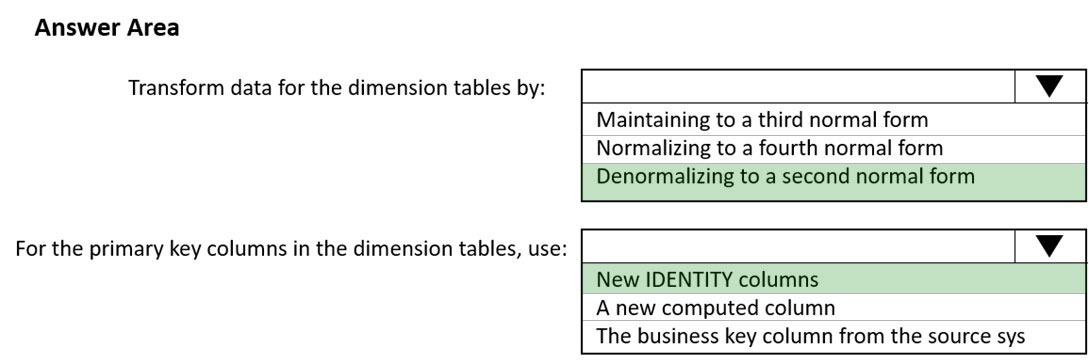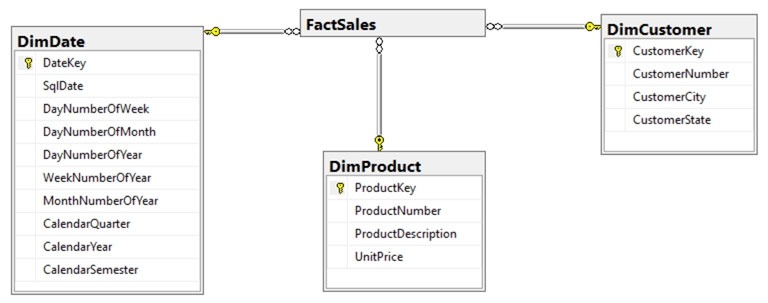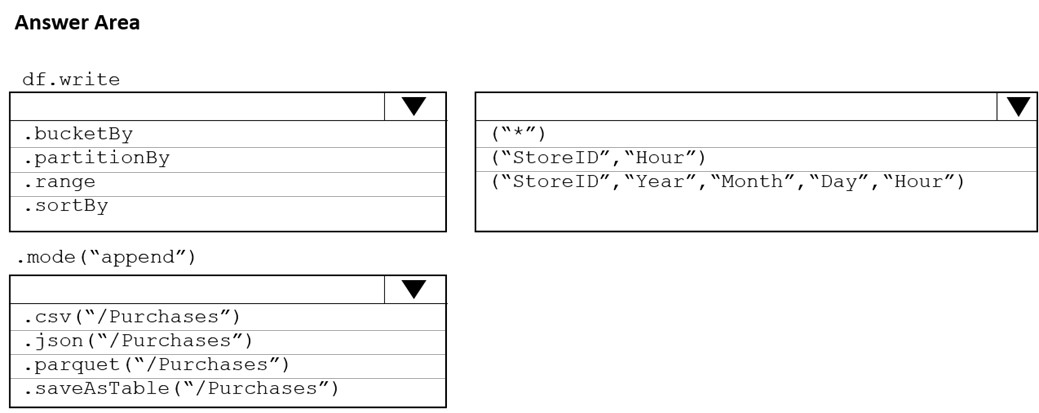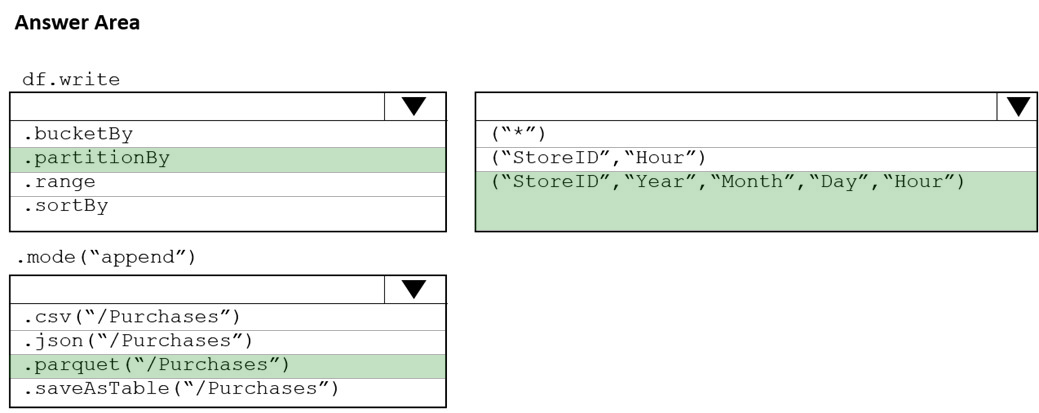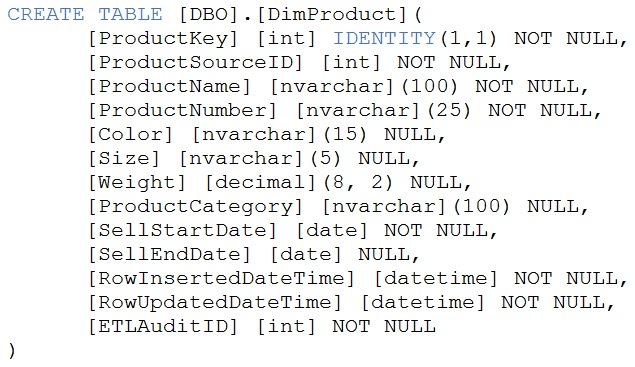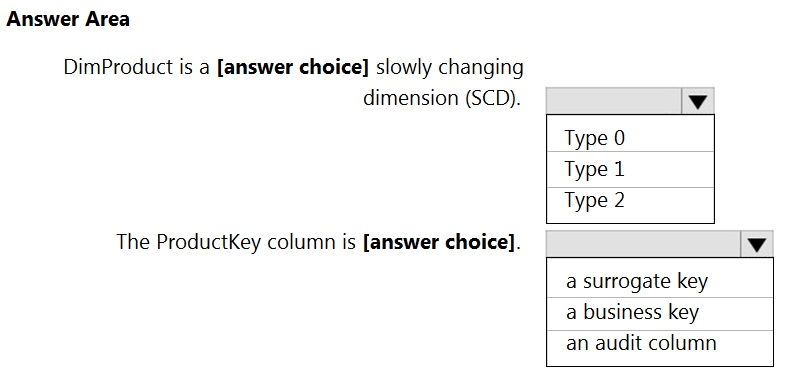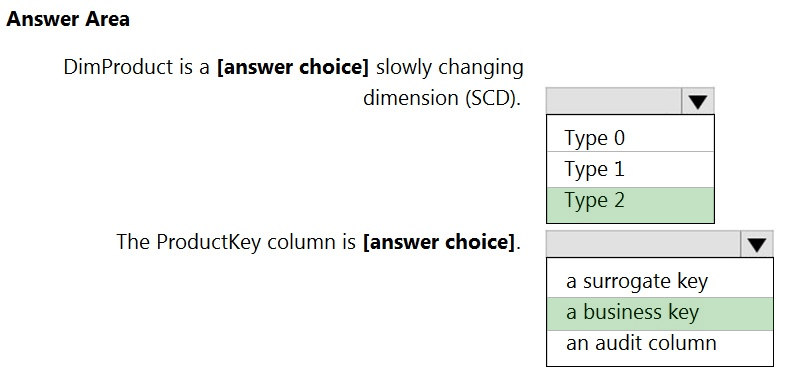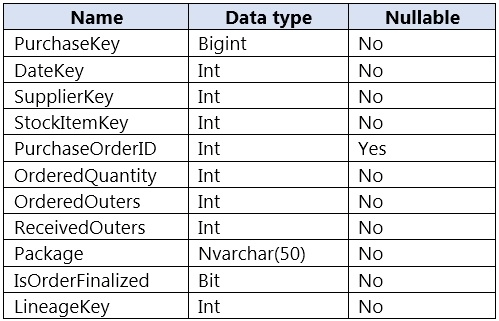Question #31
HOTSPOT –
You have an Azure Data Lake Storage Gen2 account named account1 that stores logs as shown in the following table.
You do not expect that the logs will be accessed during the retention periods.
You need to recommend a solution for account1 that meets the following requirements:
✑ Automatically deletes the logs at the end of each retention period
✑ Minimizes storage costs
What should you include in the recommendation? To answer, select the appropriate options in the answer area.
NOTE: Each correct selection is worth one point.
Hot Area:
Correct Answer:
Box 1: Store the infrastructure logs in the Cool access tier and the application logs in the Archive access tier
For infrastructure logs: Cool tier – An online tier optimized for storing data that is infrequently accessed or modified. Data in the cool tier should be stored for a minimum of 30 days. The cool tier has lower storage costs and higher access costs compared to the hot tier.
For application logs: Archive tier – An offline tier optimized for storing data that is rarely accessed, and that has flexible latency requirements, on the order of hours.
Data in the archive tier should be stored for a minimum of 180 days.
Box 2: Azure Blob storage lifecycle management rules
Blob storage lifecycle management offers a rule-based policy that you can use to transition your data to the desired access tier when your specified conditions are met. You can also use lifecycle management to expire data at the end of its life.
Reference:
https://docs.microsoft.com/en-us/azure/storage/blobs/access-tiers-overview
Question #32
You plan to ingest streaming social media data by using Azure Stream Analytics. The data will be stored in files in Azure Data Lake Storage, and then consumed by using Azure Databricks and PolyBase in Azure Synapse Analytics.
You need to recommend a Stream Analytics data output format to ensure that the queries from Databricks and PolyBase against the files encounter the fewest possible errors. The solution must ensure that the files can be queried quickly and that the data type information is retained.
What should you recommend?
- A. JSON
- B. Parquet Most Voted
- C. CSV
- D. Avro
Correct Answer:B
Need Parquet to support both Databricks and PolyBase.
Reference:
https://docs.microsoft.com/en-us/sql/t-sql/statements/create-external-file-format-transact-sql
B (100%)
Question #33
You have an Azure Synapse Analytics dedicated SQL pool named Pool1. Pool1 contains a partitioned fact table named dbo.Sales and a staging table named stg.Sales that has the matching table and partition definitions.
You need to overwrite the content of the first partition in dbo.Sales with the content of the same partition in stg.Sales. The solution must minimize load times.
What should you do?
- A. Insert the data from stg.Sales into dbo.Sales.
- B. Switch the first partition from dbo.Sales to stg.Sales.
- C. Switch the first partition from stg.Sales to dbo.Sales. Most Voted
- D. Update dbo.Sales from stg.Sales.
Correct Answer: B
A way to eliminate rollbacks is to use Metadata Only operations like partition switching for data management. For example, rather than execute a DELETE statement to delete all rows in a table where the order_date was in October of 2001, you could partition your data monthly. Then you can switch out the partition with data for an empty partition from another table
Note: Syntax:
SWITCH [ PARTITION source_partition_number_expression ] TO [ schema_name. ] target_table [ PARTITION target_partition_number_expression ]
Switches a block of data in one of the following ways:
✑ Reassigns all data of a table as a partition to an already-existing partitioned table.
✑ Switches a partition from one partitioned table to another.
✑ Reassigns all data in one partition of a partitioned table to an existing non-partitioned table.
Reference:
https://docs.microsoft.com/en-us/azure/synapse-analytics/sql/best-practices-dedicated-sql-pool
C (92%)
8%
Question #34
You are designing a slowly changing dimension (SCD) for supplier data in an Azure Synapse Analytics dedicated SQL pool.
You plan to keep a record of changes to the available fields.
The supplier data contains the following columns.
Which three additional columns should you add to the data to create a Type 2 SCD? Each correct answer presents part of the solution.
NOTE: Each correct selection is worth one point.
- A. surrogate primary key Most Voted
- B. effective start date Most Voted
- C. business key
- D. last modified date
- E. effective end date Most Voted
- F. foreign key
Correct Answer: BCE
C: The Slowly Changing Dimension transformation requires at least one business key column.
BE: Historical attribute changes create new records instead of updating existing ones. The only change that is permitted in an existing record is an update to a column that indicates whether the record is current or expired. This kind of change is equivalent to a Type 2 change. The Slowly Changing Dimension transformation directs these rows to two outputs: Historical Attribute Inserts Output and New Output.
Reference:
https://docs.microsoft.com/en-us/sql/integration-services/data-flow/transformations/slowly-changing-dimension-transformation
ABE (88%)
12%
Question #35
HOTSPOT –
You have a Microsoft SQL Server database that uses a third normal form schema.
You plan to migrate the data in the database to a star schema in an Azure Synapse Analytics dedicated SQL pool.
You need to design the dimension tables. The solution must optimize read operations.
What should you include in the solution? To answer, select the appropriate options in the answer area.
NOTE: Each correct selection is worth one point.
Hot Area:
Correct Answer:
Box 1: Denormalize to a second normal form
Denormalization is the process of transforming higher normal forms to lower normal forms via storing the join of higher normal form relations as a base relation.
Denormalization increases the performance in data retrieval at cost of bringing update anomalies to a database.
Box 2: New identity columns –
The collapsing relations strategy can be used in this step to collapse classification entities into component entities to obtain flat dimension tables with single-part keys that connect directly to the fact table. The single-part key is a surrogate key generated to ensure it remains unique over time.
Example:
Note: A surrogate key on a table is a column with a unique identifier for each row. The key is not generated from the table data. Data modelers like to create surrogate keys on their tables when they design data warehouse models. You can use the IDENTITY property to achieve this goal simply and effectively without affecting load performance.
Reference:
https://www.mssqltips.com/sqlservertip/5614/explore-the-role-of-normal-forms-in-dimensional-modeling/ https://docs.microsoft.com/en-us/azure/synapse-analytics/sql-data-warehouse/sql-data-warehouse-tables-identity
Question #36
HOTSPOT –
You plan to develop a dataset named Purchases by using Azure Databricks. Purchases will contain the following columns:
✑ ProductID
✑ ItemPrice
✑ LineTotal
✑ Quantity
✑ StoreID
✑ Minute
✑ Month
✑ Hour
Year –
✑ Day
You need to store the data to support hourly incremental load pipelines that will vary for each Store ID. The solution must minimize storage costs.
How should you complete the code? To answer, select the appropriate options in the answer area.
NOTE: Each correct selection is worth one point.
Hot Area:
Correct Answer:
Box 1: partitionBy –
We should overwrite at the partition level.
Example:
df.write.partitionBy(“y”,”m”,”d”)
.mode(SaveMode.Append)
.parquet(“/data/hive/warehouse/db_name.db/” + tableName)
Box 2: (“StoreID”, “Year”, “Month”, “Day”, “Hour”, “StoreID”)
Box 3: parquet(“/Purchases”)
Reference:
https://intellipaat.com/community/11744/how-to-partition-and-write-dataframe-in-spark-without-deleting-partitions-with-no-new-data
Question #37
You are designing a partition strategy for a fact table in an Azure Synapse Analytics dedicated SQL pool. The table has the following specifications:
✑ Contain sales data for 20,000 products.
Use hash distribution on a column named ProductID.
✑ Contain 2.4 billion records for the years 2019 and 2020.
Which number of partition ranges provides optimal compression and performance for the clustered columnstore index?
- A. 40 Most Voted
- B. 240
- C. 400
- D. 2,400
Correct Answer: A
Each partition should have around 1 millions records. Dedication SQL pools already have 60 partitions.
We have the formula: Records/(Partitions*60)= 1 million
Partitions= Records/(1 million * 60)
Partitions= 2.4 x 1,000,000,000/(1,000,000 * 60) = 40
Note: Having too many partitions can reduce the effectiveness of clustered columnstore indexes if each partition has fewer than 1 million rows. Dedicated SQL pools automatically partition your data into 60 databases. So, if you create a table with 100 partitions, the result will be 6000 partitions.
Reference:
https://docs.microsoft.com/en-us/azure/synapse-analytics/sql/best-practices-dedicated-sql-pool
A (75%)
C (25%)
Question #38
HOTSPOT –
You are creating dimensions for a data warehouse in an Azure Synapse Analytics dedicated SQL pool.
You create a table by using the Transact-SQL statement shown in the following exhibit.
Use the drop-down menus to select the answer choice that completes each statement based on the information presented in the graphic.
NOTE: Each correct selection is worth one point.
Hot Area:
Correct Answer:
Box 1: Type 2 –
A Type 2 SCD supports versioning of dimension members. Often the source system doesn’t store versions, so the data warehouse load process detects and manages changes in a dimension table. In this case, the dimension table must use a surrogate key to provide a unique reference to a version of the dimension member. It also includes columns that define the date range validity of the version (for example, StartDate and EndDate) and possibly a flag column (for example,
IsCurrent) to easily filter by current dimension members.
Incorrect Answers:
A Type 1 SCD always reflects the latest values, and when changes in source data are detected, the dimension table data is overwritten.
Box 2: a business key –
A business key or natural key is an index which identifies uniqueness of a row based on columns that exist naturally in a table according to business rules. For example business keys are customer code in a customer table, composite of sales order header number and sales order item line number within a sales order details table.
Reference:
https://docs.microsoft.com/en-us/learn/modules/populate-slowly-changing-dimensions-azure-synapse-analytics-pipelines/3-choose-between-dimension-types
Question #39
You are designing a fact table named FactPurchase in an Azure Synapse Analytics dedicated SQL pool. The table contains purchases from suppliers for a retail store. FactPurchase will contain the following columns.
FactPurchase will have 1 million rows of data added daily and will contain three years of data.
Transact-SQL queries similar to the following query will be executed daily.
SELECT –
SupplierKey, StockItemKey, COUNT(*)
FROM FactPurchase –
WHERE DateKey >= 20210101 –
AND DateKey <= 20210131 –
GROUP By SupplierKey, StockItemKey
Which table distribution will minimize query times?
- A. replicated
- B. hash-distributed on PurchaseKey Most Voted
- C. round-robin
- D. hash-distributed on DateKey
Correct Answer: B
Hash-distributed tables improve query performance on large fact tables, and are the focus of this article. Round-robin tables are useful for improving loading speed.
Incorrect:
Not D: Do not use a date column. . All data for the same date lands in the same distribution. If several users are all filtering on the same date, then only 1 of the 60 distributions do all the processing work.
Reference:
https://docs.microsoft.com/en-us/azure/synapse-analytics/sql-data-warehouse/sql-data-warehouse-tables-distribute
B (80%)
C (20%)
Question #40
You are implementing a batch dataset in the Parquet format.
Data files will be produced be using Azure Data Factory and stored in Azure Data Lake Storage Gen2. The files will be consumed by an Azure Synapse Analytics serverless SQL pool.
You need to minimize storage costs for the solution.
What should you do?
- A. Use Snappy compression for the files. Most Voted
- B. Use OPENROWSET to query the Parquet files. Most Voted
- C. Create an external table that contains a subset of columns from the Parquet files. Most Voted
- D. Store all data as string in the Parquet files.
Correct Answer:C
An external table points to data located in Hadoop, Azure Storage blob, or Azure Data Lake Storage. External tables are used to read data from files or write data to files in Azure Storage. With Synapse SQL, you can use external tables to read external data using dedicated SQL pool or serverless SQL pool.
Reference:
https://docs.microsoft.com/en-us/azure/synapse-analytics/sql/develop-tables-external-tables
C (37%)
A (37%)



